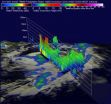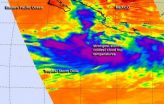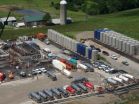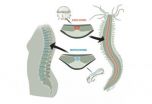(Press-News.org) As Tropical Storm Odile continues to affect Mexico's west coast and stir up dangerous surf, NASA's TRMM and Aqua satellites provided forecasters information on clouds and rainfall in the coast-hugging storm. On September 12, A Tropical Storm Watch remained in effect from Manzanillo to Cabo Corrientes, Mexico.
Tropical Storm Odile formed on September 10, 2014 in the same area where Norbert formed.
Gathering Rainfall and Thunderstorm Height Information
The Tropical Rainfall Measuring Mission or TRMM satellite flew over tropical storm Odile on September 11, 2014 at 0418 UTC (12:18 a.m. EDT) and collected rainfall data. A rainfall analysis made from TRMM's Microwave Imager (TMI) and Precipitation Radar (PR) data was overlaid on an enhanced infrared image of Odile's clouds from NOAA's GOES-West satellite to show where the rain was falling within that cloud shield (or the extent of the clouds). The coupled image showed that Odile was dropping rain at the extreme rate of over 196 mm (7.8 inches) per hour in powerful thunderstorms near Odile's center of circulation.
TRMM satellite radar reflectivity (which means the satellite reads signals bounced off the clouds and back to the satellite) data was used to create a simulated 3-D view (toward the east) of Odile's rainfall structure. The 3-D image showed the most intense thunderstorms were reaching altitudes of over 14.7 km (about 9.1 miles). The release of this much energy would normally lead to intensification but northeasterly vertical wind shear was dampening Odile. By September 12, that wind shear was relaxing, which will enable Odile to strengthen.
Taking the Cloud Top Temperatures
Later on September 11, NASA's Aqua satellite passed over Odile and the Atmospheric Infrared Sounder or AIRS instrument provided temperature data of Odile's cloud tops. The AIRS data confirmed the TRMM data, showing the coldest cloud tops in powerful thunderstorms circling the center of the storm. The AIRS data was false-colored to better show temperature differences at NASA's Jet Propulsion Laboratory in Pasadena, California. The coldest cloud tops were near -63F/-53C in storms circling Odile's center.
Odile's Location on September 12
At 8 a.m. EDT on September 12, Odile's maximum sustained winds were near 60 mph (95 kph) and some strengthening is forecast during the next 48 hours. The National Hurricane Center (NHC) advised that Odile could become a hurricane by tonight (Sept. 12). Odile's center was located near latitude 15.5 north and longitude 105.0 west. Odile is drifting toward the west near 2 mph (4 kph) and expected to move to the west-northwest and then northwest while picking up speed over the next day.
Dangerous Surf for Southwestern Mexico Over the Weekend
Odile's center is forecast will remain well offshore of the southwestern coast of Mexico through Sunday, September 14. Despite the center remaining off-shore, ocean swells are expected to affect the southwestern coast of Mexico over the next couple of days creating dangerous surf and riptides.
The NHC forecast calls for Odile to intensify into a hurricane and move in a northwesterly direction parallel to the west coast of Mexico. Odile is expected to follow close to the same track as hurricane Norbert and pass to the west of the southern tip of Baja California on Monday, September 15.
INFORMATION:
Tropical Storm Odile taken on by 2 NASA satellites
2014-09-12
ELSE PRESS RELEASES FROM THIS DATE:
CCNY analysis explains rich bird biodiversity in Neotropics
2014-09-12
Applying analyses designed by City College of New York biologist Mike Hickerson, a team of international researchers is challenging a commonly held view that explains how so many species of birds ended up in the Neotropics, an area rich in rain forest extending from Mexico to the southernmost tip of South America. It is home to the most bird species on Earth.
"The unanswered question has been—how did this extraordinary bird diversity originate?" said Dr. Brian Smith, lead author of a paper on the subject published in the journal Nature this week and an assistant curator ...
Fluid mechanics suggests alternative to quantum orthodoxy
2014-09-12
The central mystery of quantum mechanics is that small chunks of matter sometimes seem to behave like particles, sometimes like waves. For most of the past century, the prevailing explanation of this conundrum has been what's called the "Copenhagen interpretation" — which holds that, in some sense, a single particle really is a wave, smeared out across the universe, that collapses into a determinate location only when observed.
But some founders of quantum physics — notably Louis de Broglie — championed an alternative interpretation, known as "pilot-wave theory," which ...
Corn spots: Study finds important genes in defense response
2014-09-12
When corn plants come under attack from a pathogen, they sometimes respond by killing their own cells near the site of the attack, committing "cell suicide" to thwart further damage from the attacker. This cell sacrifice can cause very small, often microscopic, spots or lesions on the plant.
But up until now it's been difficult to understand how the plant regulates this "spotty" defense mechanism because the response is so quick and localized.
Researchers at North Carolina State University have identified a number of candidate genes and cellular processes that appear ...
Experts call for massive global response to tackle Ebola
2014-09-12
AUDIO:
Professor Peter Piot, Director of the London School of Hygiene & Tropical Medicine, explains how he co-discovered the Ebola virus in 1976, and gives his views on the current Ebola...
Click here for more information.
The current Ebola outbreak now requires a "rapid response at a massive global scale", according to experts at the London School of Hygiene & Tropical Medicine.
Writing an editorial in Science, Professor Peter Piot, co-discoverer of the virus, says that the ...
Stanford-led study assesses the environmental costs and benefits of fracking
2014-09-12
A strange thing happened on the way to dealing with climate change: Advances in hydraulic fracturing put trillions of dollars' worth of previously unreachable oil and natural gas within humanity's grasp.
The environmental costs – and benefits – from "fracking," which requires blasting huge amounts of water, sand and chemicals deep into underground rock formations, are the subject of new research that synthesizes 165 academic studies and government databases. The survey covers not only greenhouse gas impacts but also fracking's influence on local air pollution, earthquakes ...
Piglet health
2014-09-12
Porcine neonatal coccidiosis is a serious parasitic infection of young piglets that severely damages the intestinal mucosa, leading to diarrhoea and reduced nutritional intake. As the infection reduces animal growth, and because secondary infections can result in increased mortality, the disease is responsible for substantial economic losses at affected pig farms.
"The developing immune system of neonatal piglets is not yet mature enough to deal with the parasites. For this reason, an infection shortly after birth results in weakened intestinal tissue with appropriate ...
Moving silicon atoms in graphene with atomic precision
2014-09-12
Richard Feynman famously posed the question in 1959: is it possible to see and manipulate individual atoms in materials? For a time his vision seemed more science fiction than science, but starting with groundbreaking experiments in the late 1980s and more recent developments in electron microscopy instrumentation it has become scientific reality. However, damage caused by the electron beam is often an issue in such experiments.
The present study focused on single-layer graphene with silicon atoms embedded into the lattice, previously created and studied by the collaborators ...
Cutting the cloud computing carbon cost
2014-09-12
Cloud computing involves displacing data storage and processing from the user's computer on to remote servers. It can provide users with more storage space and computing power that they can then access from anywhere in the world rather than having to connect to a single desktop or other computer with its finite resources. However, some observers have raised concerns about the increased energy demands of sustaining distributed servers and having them up and running continuously, where an individual user's laptop might be shut down when it is not in use or the resources utilization ...
From worm muscle to spinal discs
2014-09-12
Thoughts of the family tree may not be uppermost in the mind of a person suffering from a slipped disc, but those spinal discs provide a window into our evolutionary past. They are remnants of the first vertebrate skeleton, whose origins now appear to be older than had been assumed. Scientists at the European Molecular Biology Laboratory (EMBL) in Heidelberg, Germany, have found that, unexpectedly, this skeleton most likely evolved from a muscle. The study, carried out in collaboration with researchers at the Howard Hughes Medical Institute in Janelia Farm, USA, is published ...
New family of materials for energy-efficient information storage and processing
2014-09-12
Switching the polarity of a magnet using an electric field (magnetoelectric memory [MEM] effect), can be a working principle of the next-generation technology for information processing and storage. Multiferroic materials are promising candidates for the MEM effect, due to the coexistence of electric and magnetic orders. On the other hand, the coexistence of spontaneous electric and magnetic polarizations is rare in known materials, which hinders the application potential of the MEM effect. This article briefly reviews a new family of multiferroic materials—hexagonal rare ...





